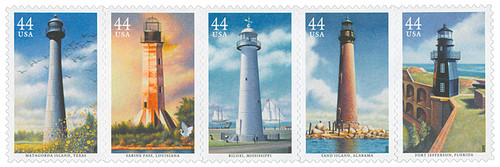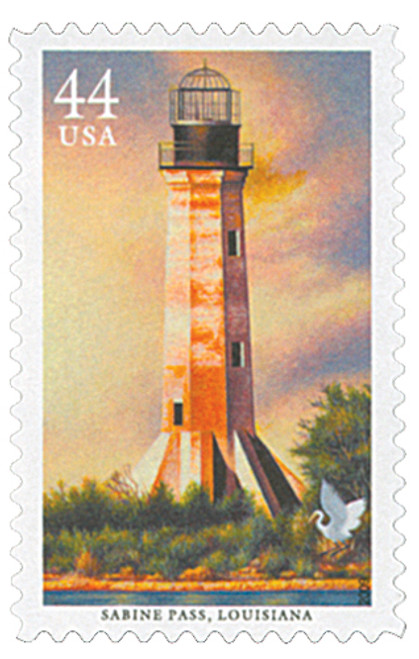
# 4412 FDC - 2009 44c Gulf Coast Lighthouses: Sand Island, Alabama
Gulf Coast Lighthouses
Sand Island, Alabama
Issue Date: July 23, 2009
City: Biloxi, MS
In 1862, Union blockaders installed a lens in Alabama’s disabled Sand Island lighthouse to spy on the Confederates. The tower offered a clear view of Mobile Bay, a strategically important location during the Civil War. Outraged, John W. Glenn led a small band of Confederates across Mobile Bay and set off 70 pounds of gunpowder under the lighthouse.
Glenn’s report on the raid was delivered to Confederate General Danville Leadbetter, who ironically had directed the Sand Island lighthouse construction for the U.S. Army Engineers years earlier.
War was only one threat the Sand Island lighthouse faced. The original lighthouse on Sand Island had been completed in 1830. The iron spindle tower, which was surrounded by 400 acres of land, was visible for six miles. A few years later, a survey reported the island had lost a strip “the whole length of the eastern shore from 66 to 100 yards in width.”
Erosion continued year after year. Despite several attempts to halt the loss of land, only ten feet of sand separated the rebuilt lighthouse from the Gulf of Mexico in 1888. Over 8,100 tons of granite were placed around the tower before a powerful hurricane struck the lighthouse in 1906. Although it sits on less than one acre of land today, efforts to restore the historic Sand Island lighthouse continue.
Gulf Coast Lighthouses
Sand Island, Alabama
Issue Date: July 23, 2009
City: Biloxi, MS
In 1862, Union blockaders installed a lens in Alabama’s disabled Sand Island lighthouse to spy on the Confederates. The tower offered a clear view of Mobile Bay, a strategically important location during the Civil War. Outraged, John W. Glenn led a small band of Confederates across Mobile Bay and set off 70 pounds of gunpowder under the lighthouse.
Glenn’s report on the raid was delivered to Confederate General Danville Leadbetter, who ironically had directed the Sand Island lighthouse construction for the U.S. Army Engineers years earlier.
War was only one threat the Sand Island lighthouse faced. The original lighthouse on Sand Island had been completed in 1830. The iron spindle tower, which was surrounded by 400 acres of land, was visible for six miles. A few years later, a survey reported the island had lost a strip “the whole length of the eastern shore from 66 to 100 yards in width.”
Erosion continued year after year. Despite several attempts to halt the loss of land, only ten feet of sand separated the rebuilt lighthouse from the Gulf of Mexico in 1888. Over 8,100 tons of granite were placed around the tower before a powerful hurricane struck the lighthouse in 1906. Although it sits on less than one acre of land today, efforts to restore the historic Sand Island lighthouse continue.










